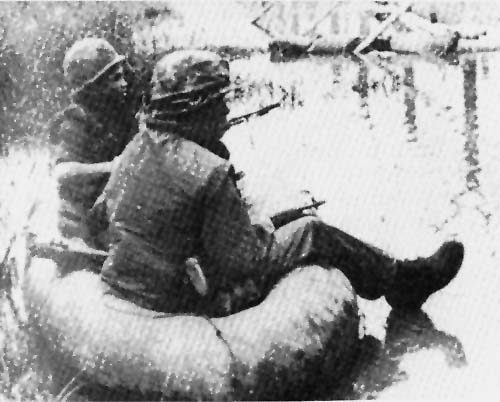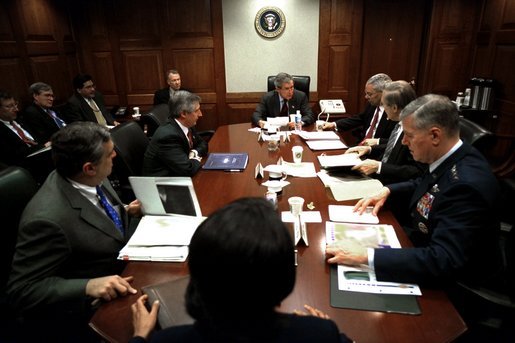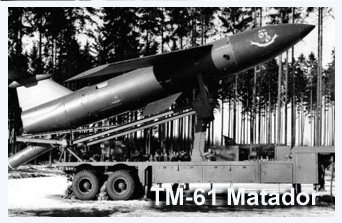|
Korean DMZ Conflict (1966–69)
The Korean DMZ Conflict, also referred to as the Second Korean War by some, was a series of low-level armed clashes between North Korean forces and the forces of South Korea and the United States, largely occurring between 1966 and 1969 at the Korean DMZ. Background The Korean War had devastated both North and South Korea, and while neither side renounced its claims to reunify Korea under its control, neither side was in a position to force reunification. In September 1956, Chairman of the Joint Chiefs of Staff Admiral Radford indicated within the U.S. government that the military's intention was to introduce atomic weapons into Korea, which was agreed to by the United States National Security Council and President Eisenhower. However paragraph 13(d) of the Korean Armistice Agreement mandated that both sides could not introduce new types of weapons into Korea, so preventing the introduction of nuclear weapons and missiles. The U.S. decided to unilaterally abrogate paragraph 13 ... [...More Info...] [...Related Items...] OR: [Wikipedia] [Google] [Baidu] |
Korean Conflict
The Korean conflict is an ongoing conflict based on the division of Korea between North Korea (Democratic People's Republic of Korea) and South Korea (Republic of Korea), both of which claim to be the sole legitimate government of all of Korea. During the Cold War, North Korea was backed by the Soviet Union, China, and other allies, while South Korea was backed by the United States and its Western allies. The division of Korea by the United States and the Soviet Union occurred in 1945. Both superpowers created a government in their own image. Tensions erupted into the Korean War, which lasted from 1950 to 1953. When the war ended, both countries were devastated but the division remained. North and South Korea continued a military standoff, with periodic clashes. The conflict survived the end of the Cold War and continues to this day. The US maintains a military presence in the South to assist South Korea in accordance with the ROK–US Mutual Defense Treaty. In 1997, US Pr ... [...More Info...] [...Related Items...] OR: [Wikipedia] [Google] [Baidu] |
United States National Security Council
The United States National Security Council (NSC) is the principal forum used by the President of the United States for consideration of national security, military, and foreign policy matters. Based in the White House, it is part of the Executive Office of the President of the United States, and composed of senior national security advisors and Cabinet officials. Since its inception in 1947 by President Harry S. Truman, the function of the Council has been to advise and assist the President on national security and foreign policies. It also serves as the President's principal arm for coordinating these policies among various government agencies. The Council has subsequently played a key role in most major events in U.S. foreign policy, from the Korean War to the War on Terror. The NSC has counterparts in the national security councils of many other nations. History The immediate predecessor to the National Security Council was the National Intelligence Authority (NIA), wh ... [...More Info...] [...Related Items...] OR: [Wikipedia] [Google] [Baidu] |
April Revolution
The April Revolution ( ko, 4.19 혁명), also called the April 19 Revolution or April 19 Movement, were mass protests in South Korea against President Syngman Rhee and the First Republic from April 11 to 26, 1960 which led to Rhee's resignation. Protests opposing Rhee were started by student and labor groups in the southeastern port city of Masan on April 11. The protests were triggered by the discovery of the body of a local high school student who had been killed by police during demonstrations against rigged elections in March. Popular discontent had arisen due to Rhee's autocratic rule, corruption, use of violence against political opposition, and uneven development of South Korea. The Masan discovery led to large student protests in Seoul, which were violently suppressed; a total of 186 people were killed during the two weeks of protest. Rhee resigned on April 26 before fleeing to exile in the United States, and was replaced by Yun Posun, beginning the transition to the ... [...More Info...] [...Related Items...] OR: [Wikipedia] [Google] [Baidu] |
Chollima Movement
The Chollima Movement () was a state-sponsored Stakhanovite movement in North Korea intended to promote rapid economic development. Launched in 1956 or 1958, the movement emphasized "ideological incentives to work harder" and the personal guidance of Kim Il-sung rather than rational modes of economic management. Origin The term Chollima originates from the Chinese mythological flying horse. The word Chollima can be translated as "thousand li horse," referring to its ability to travel 1,000 li (500 kilometers) in a single day. It also was said that it could not be ridden by any person. It is known for accomplishing the most difficult tasks and to have led heroes to victory. This idea of Chollima was used by Kim Il-sung to energize the workers in North Korea to bring the country out of the rubble of the Korean War to obtain a better life and a more prosperous country in a short amount of time. Kim Il-sung first introduced the term Chollima in December 1956,Jefferies, "North Korea ... [...More Info...] [...Related Items...] OR: [Wikipedia] [Google] [Baidu] |
Kim Il-Sung
Kim Il-sung (; , ; born Kim Song-ju, ; 15 April 1912 – 8 July 1994) was a North Korean politician and the founder of North Korea, which he ruled from the country's establishment in 1948 until his death in 1994. He held the posts of Premier from 1948 to 1972 and President from 1972 to 1994. He was the leader of the Workers' Party of Korea (WPK) from 1949 to 1994 (titled as Chairman from 1949 to 1966 and as General Secretary after 1966). Coming to power after the end of Japanese rule in 1945, he authorized the invasion of South Korea in 1950, triggering an intervention in defense of South Korea by the United Nations led by the United States. Following the military stalemate in the Korean War, a ceasefire was signed on 27 July 1953. He was the third longest-serving non-royal head of state/government in the 20th century, in office for more than 45 years. Under his leadership, North Korea was established as a socialist state with a centrally planned economy. It had c ... [...More Info...] [...Related Items...] OR: [Wikipedia] [Google] [Baidu] |
People's Liberation Army
The People's Liberation Army (PLA) is the principal military force of the People's Republic of China and the armed wing of the Chinese Communist Party (CCP). The PLA consists of five service branches: the Ground Force, Navy, Air Force, Rocket Force, and Strategic Support Force. It is under the leadership of the Central Military Commission (CMC) with its chairman as commander-in-chief. The PLA can trace its origins during the Republican Era to the left-wing units of the National Revolutionary Army (NRA) of the Kuomintang (KMT) when they broke away on 1 August 1927 in an uprising against the nationalist government as the Chinese Red Army before being reintegrated into the NRA as units of New Fourth Army and Eighth Route Army during the Second Sino-Japanese War. The two NRA communist units were reconstituted into the PLA on 10 October 1947. Today, the majority of military units around the country are assigned to one of five theater commands by geographical location. ... [...More Info...] [...Related Items...] OR: [Wikipedia] [Google] [Baidu] |
Soviet Union
The Soviet Union,. officially the Union of Soviet Socialist Republics. (USSR),. was a transcontinental country that spanned much of Eurasia from 1922 to 1991. A flagship communist state, it was nominally a federal union of fifteen national republics; in practice, both its government and its economy were highly centralized until its final years. It was a one-party state governed by the Communist Party of the Soviet Union, with the city of Moscow serving as its capital as well as that of its largest and most populous republic: the Russian SFSR. Other major cities included Leningrad (Russian SFSR), Kiev (Ukrainian SSR), Minsk ( Byelorussian SSR), Tashkent (Uzbek SSR), Alma-Ata (Kazakh SSR), and Novosibirsk (Russian SFSR). It was the largest country in the world, covering over and spanning eleven time zones. The country's roots lay in the October Revolution of 1917, when the Bolsheviks, under the leadership of Vladimir Lenin, overthrew the Russian Provisional Government ... [...More Info...] [...Related Items...] OR: [Wikipedia] [Google] [Baidu] |
China
China, officially the People's Republic of China (PRC), is a country in East Asia. It is the world's most populous country, with a population exceeding 1.4 billion, slightly ahead of India. China spans the equivalent of five time zones and borders fourteen countries by land, the most of any country in the world, tied with Russia. Covering an area of approximately , it is the world's third largest country by total land area. The country consists of 22 provinces, five autonomous regions, four municipalities, and two Special Administrative Regions (Hong Kong and Macau). The national capital is Beijing, and the most populous city and financial center is Shanghai. Modern Chinese trace their origins to a cradle of civilization in the fertile basin of the Yellow River in the North China Plain. The semi-legendary Xia dynasty in the 21st century BCE and the well-attested Shang and Zhou dynasties developed a bureaucratic political system to serve hereditary monarchies, or dyna ... [...More Info...] [...Related Items...] OR: [Wikipedia] [Google] [Baidu] |
MGM-1 Matador
The Martin MGM-1 Matador was the first operational surface-to-surface cruise missile designed and built by the United States. It was developed after World War II, drawing upon their wartime experience with creating the Republic-Ford JB-2, a copy of the German V-1. The Matador was similar in concept to the V-1, but it included a radio command that allowed in-flight course corrections. This allowed accuracy to be maintained over greatly extended ranges of just under 1000 km. To allow these ranges, the Matador was powered by a small turbojet engine in place of the V-1's much less efficient pulsejet. Matador was armed with the W5 nuclear warhead, essentially an improved version of the Fat Man design that was lighter and had a smaller cross section. A single U.S. Air Force group, 1st Pilotless Bomber Squadron, was armed with the weapon, keeping them on alert with a six-minute launch time. It could be easily retargeted, unlike weapons using inertial guidance systems. Accurac ... [...More Info...] [...Related Items...] OR: [Wikipedia] [Google] [Baidu] |
Atomic Demolition Munitions
Atomic demolition munitions (ADMs), colloquially known as nuclear land mines, are small nuclear explosive devices. ADMs were developed for both military and civilian purposes. As weapons, they were designed to be exploded in the forward battle area, in order to block or channel enemy forces. Non-militarily, they were designed for demolition, mining or earthmoving. However, apart from testing, they have never been used for either purpose. Military uses Instead of being delivered to the target by missiles, rockets, or artillery shells, ADMs were intended to be emplaced by soldiers. Due to their relatively small size and light weight, ADMs could be emplaced by military engineers or special forces teams, then detonated on command or by timer to create massive obstructions. By destroying key terrain features or choke points such as bridges, dams, mountain passes and tunnels, ADMs could serve to create physical as well as radiological obstacles to the movement of enemy forces and thu ... [...More Info...] [...Related Items...] OR: [Wikipedia] [Google] [Baidu] |
Honest John Missile
The MGR-1 Honest John rocket was the first nuclear weapon, nuclear-capable surface-to-surface rocket in the United States arsenal.The first nuclear-authorized ''guided'' missile was the MGM-5 Corporal. Originally designated Artillery Rocket XM31, the first unit was tested on 29 June 1951, with the first production rounds delivered in January 1953. Its designation was changed to M31 in September 1953. The first Army units received their rockets by year's end and Honest John battalions were deployed in Europe in early 1954. Alternatively, the rocket was capable of carrying an ordinary high-explosive warhead weighing . History and development Developed at Redstone Arsenal, Alabama, the Honest John was a large but simple Vertical stabilizer, fin-stabilized, Rocket artillery, unguided artillery rocket weighing in its initial M31 nuclear-armed version. Mounted on the back of a truck, the rocket was aimed in much the same way as a cannon and then fired up an elevated ramp, igniting ... [...More Info...] [...Related Items...] OR: [Wikipedia] [Google] [Baidu] |




.jpg)

.jpg)
